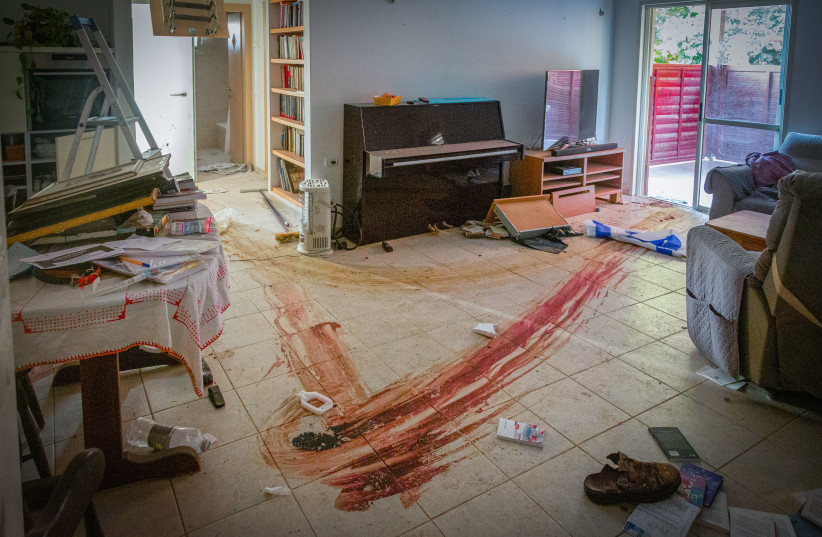Shin Bet interrogations break open Hamas strategy, operations
In contrast, many other detainees were less well-trained and, in some cases, spontaneously joined the slaughter when they heard about the success in breaking into Israel as it was happening.
Separately, the Shin Bet and IDF have established both a system that constantly updates information about the October 7 invasion, as well as a new physical apparatus in the South to assist with ongoing targeting and IDF counter-invasion maneuvering operations.
This information is regularly helping with deciding whether to attack specific targets and when to attack those targets, sometimes enabling IDF forces on the front to attack a target within an hour.
There is also electronic intelligence the IDF collects, often from aerial surveillance and other sensors, which enables the IDF to attack especially block-to-block targets even faster – sometimes within minutes.
In contrast, the Shin Bet information, while also sometimes used at a smaller tactical level, often involves higher-value targets, such as top Hamas commanders or critical Hamas terror infrastructure.

One of the targeted killings the Shin Bet facilitated is the assassination on November 11 of Ahmed Siam, a Hamas Naser Radwan company commander who had held about 1,000 Gazan civilians hostage in Gaza’s Rantisi Hospital to use them as human shields. That assassination had a dramatic impact on the broader situation in the field, such as facilitating large numbers of Palestinian civilians escaping from being essentially held hostage by Siam.
Additionally, the Post has learned that some Shin Bet interrogations have led to more fundamental changes in IDF attack plans, sometimes in real-time, after a deeper understanding of Hamas’s defense plans.
Other strategic impacts from Shin Bet interrogations include unmasking Hamas’s systematic use of hospitals, ambulances, mosques, and other sensitive civilian locations for its terror operations.
On November 8, the Shin Bet specifically used interrogations to publicly disclose the full extent of Hamas’s use of the above categories of locations, as well as health clinics and schools, for terror purposes.
Ambulances used for terrorism
A terrorist interrogated by the Shin Bet admitted that Hamas uses ambulances to transport weapons and terrorists throughout the Gaza Strip.
“I can leave with any ambulance I want,” the terrorist acknowledged.
Moreover, he said, “Al-Qassam [Brigades] has its own ambulances, some of which are also at the military base… the appearance of ambulances is similar to civilian ambulances so that they do not arouse suspicion or be bombed by Israel.
“During combat, ambulances are also used to evacuate fighters and operatives,” he said. “They also transport food, IEDs [improvised explosive devices], and weapons, because that’s the safest way to get there.”
Next, the terrorist confessed, “Most of Hamas’s senior political and military figures are hiding in hospitals, especially Shifa Hospital. They take advantage of the hospitals so they won’t be bombed.”
Despite the terrorist’s statement put out on November 8, while the IDF found extensive proof of Hamas’s terror activities at Shifa Hospital following entering the complex on November 15, the IDF later backed off of claims that Hamas’s highest officials had been there, saying instead it had meant battalion-level Hamas commanders (mid-senior level).
The terrorist then went on to explain how a lot of the Gaza Strip had been booby-trapped with cables connecting explosives to the operating systems in mosques and civilian clinics.
On October 23, the Shin Bet disclosed videos of six separate interrogations of Hamas terrorists captured on October 7.
Each terrorist had a slightly different experience, but the Shin Bet flagged some common themes. All the Hamas agents were given explicit instructions to kill and kidnap civilians including the elderly along with women and children. While they did this, the Shin Bet emphasized that their senior commanders stayed behind in secure areas in Gaza.
One of the terrorists told Israeli forces that they were told: “Whoever brings a hostage back [to Gaza] gets $10,000 and an apartment.”
Indiscriminate killing of civilians
They said that the plan had been to take over the towns they attacked and to hold positions there once they had finished killing and kidnapping the residents.
The video released by the Shin Bet and the police shows the various Hamas operatives going into extreme detail about their activities on the morning of October 7.
“The instructions were to kidnap women and children,” said one. Another described an encounter with a dead body, saying: “Her body was lying on the floor. I shot her, and my commander yelled at me for wasting bullets on a dead body.”
They made it clear that when it came to murder, they were not to distinguish between civilians and soldiers.
Some Shin Bet interrogators may be working round the clock for weeks to wear down critical detainees or to obtain additional helpful intelligence from them after limited initial success.
In an unusual twist, a large number of Shin Bet retirees have returned to service during the war to better shoulder the full brunt of the wide number of tasks the Shin Bet is handling during wartime.
Maya Zanger-Nadis and Jerusalem Post Staff contributed to this story.





Comments are closed.